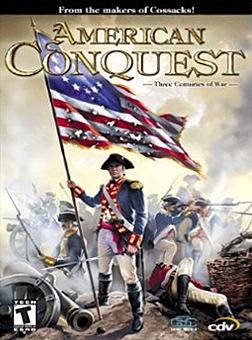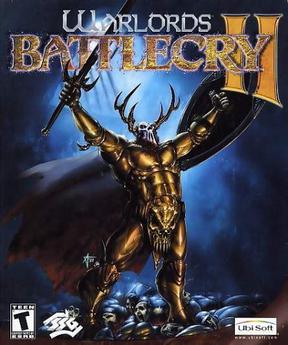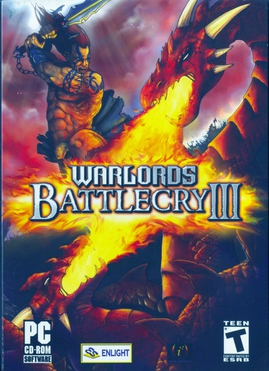Real-time strategy (RTS) is a subgenre of strategy video games that does not progress incrementally in turns, but allow all players to play simultaneously, in "real time". By contrast, in turn-based strategy (TBS) games, players take turns to play. The term "real-time strategy" was coined by Brett Sperry to market Dune II in the early 1990s.

A role-playing video game, a role-playing game (RPG) or computer role-playing game (CRPG), is a video game genre where the player controls the actions of a character immersed in some well-defined world, usually involving some form of character development by way of recording statistics. Many role-playing video games have origins in tabletop role-playing games and use much of the same terminology, settings, and game mechanics. Other major similarities with pen-and-paper games include developed story-telling and narrative elements, player character development, complexity, as well as replay value and immersion. The electronic medium removes the necessity for a gamemaster and increases combat resolution speed. RPGs have evolved from simple text-based console-window games into visually rich 3D experiences.

WarCry is an out-of-print collectible card game set in the world of Warhammer Fantasy and published by Sabertooth Games. The base game cards were released in 2003, with newer expansions introduced in the months since. A video game adaptation, titled Warhammer: Battle for Atluma, was created for the PSP in 2006.
Warlords is a video game series created by Steve Fawkner, in which role-playing elements are combined with turn-based strategy in a fantasy setting. The series began with Warlords in 1990 and includes three other games, two expansion packs, and several spinoffs.
Tactical role-playing games, also known as strategy role-playing games and in Japan as simulation RPGs, are a video game genre that combines core elements of role-playing video games with those of tactical strategy video games. The formats of tactical RPGs are much like traditional tabletop role-playing games and strategy games in appearance, pacing, and rule structure. Likewise, early tabletop role-playing games are descended from skirmish wargames such as Chainmail, which were primarily concerned with combat.

Warlords IV: Heroes of Etheria is a turn-based strategy video game developed by Infinite Interactive and published by Ubi Soft. It is the fourth in the Warlords series.

Dungeons & Dragons: Dragonshard is a real-time strategy role-playing video game, developed for Microsoft Windows by Liquid Entertainment, and published by Atari in September 2005. It takes place in Eberron, one of the official Dungeons & Dragons campaign settings. The game combines elements of traditional real-time strategy gameplay with role-playing elements such as hero units, and questing. Dragonshard includes two single-player campaigns, single-player skirmish maps, and multiplayer support. The single-player campaign follows the struggles of three competing factions to gain control of a magical artifact known as the Heart of Siberys.

Disciples II: Dark Prophecy is a 2002 turn-based strategy game by Strategy First for Microsoft Windows. It is the sequel to the 1999 game Disciples: Sacred Lands, and has become significantly more successful in terms of both sales and popularity than its predecessor. A collector's edition version of the game was released, which included a card game based upon the story and five extra quests.

Disciples: Sacred Lands is a turn-based strategy game published by Strategy First in 1999. Set in a fantasy world known as the Sacred Lands, it depicts a battle for dominance between the races of the world of Nevendaar. In 2001, an expanded version of the game was released titled Disciples: Sacred Lands - Gold Edition, which added 25 new scenarios.

American Conquest is a real-time strategy video game developed by GSC Game World and published by CDV Software Entertainment. It is set between the 15th and the early 19th centuries in the American continents. There is also an expansion pack produced for American Conquest, called American Conquest: Fight Back and a gold edition, which has both the original and expansion pack bundled together. The latest installment in the series is American Conquest: Divided Nation. All three titles are available together as the American Conquest Chronicles.
Real-time tactics (RTT) is a subgenre of tactical wargames played in real-time, simulating the considerations and circumstances of operational warfare and military tactics. It is differentiated from real-time strategy gameplay by the lack of classic resource micromanagement and base or unit building, as well as the greater importance of individual units and a focus on complex battlefield tactics.

Warhammer: Mark of Chaos is a real-time tactics game set in the Warhammer universe. It was developed by Black Hole Entertainment and co-published by Namco Bandai Games in North America and Deep Silver in PAL territories in November 2006.

Warhammer 40,000: Dawn of War – Dark Crusade is the second expansion to the real-time strategy video game Warhammer 40,000: Dawn of War developed by Relic Entertainment and published by THQ. Based on Games Workshop's tabletop wargame, Warhammer 40,000, Dark Crusade was released on October 9, 2006. The expansion features two new races, the Tau Empire and the Necrons. Including the Imperial Guard from Dawn of War's first expansion pack Winter Assault, a total of seven playable races in this expansion.

Warlords Battlecry II is a real-time strategy and role-playing game, developed by Strategic Studies Group (SSG) as the sequel to Warlords Battlecry. It was released on March 12, 2002. The game requires the player to build buildings and create units in order to defeat the enemy, while sending their hero on optional quests.

Warlords Battlecry III is a real-time strategy game developed by Infinite Interactive and published in 2004. It is the third installment in the Warlords Battlecry series and the sequel to Warlords Battlecry II.
Strategy is a major video game genre that emphasizes thinking and planning over direct instant action in order to achieve victory. Although many types of video games can contain strategic elements, as a genre, strategy games are most commonly defined as those with a primary focus on high-level strategy, logistics and resource management. They are also usually divided into two main sub-categories: turn-based and real-time, but there are also many strategy cross/sub-genres that feature additional elements such as tactics, diplomacy, economics and exploration.

Age of Wonders III is a 2014 4X turn-based strategy video game developed and published by Dutch developer Triumph Studios. It is the fourth game in the Age of Wonders series, following Age of Wonders, Age of Wonders II: The Wizard's Throne and Age of Wonders: Shadow Magic released in 1999, 2002, and 2003 respectively. It was released on March 31, 2014, through digital distribution, as well as through retail in select territories for Microsoft Windows. A port to Linux and OS X was released on April 14, 2015.

Total War: Warhammer is a 2016 turn-based strategy and real-time tactics video game developed by Creative Assembly and published by Sega for Windows via the Steam gaming platform. The game was brought to macOS and Linux by Feral Interactive. The game features the gameplay of the Total War series with factions of Games Workshop's Warhammer Fantasy series; it is the first Total War game not to portray a historical setting. It is the 10th title in the Total War series and the first title to be released in the Total War: Warhammer trilogy.

Total War: Warhammer II is a turn-based strategy and real-time tactics video game developed by Creative Assembly and published by Sega. It is part of the Total War series and the sequel to 2016's Total War: Warhammer. The game is set in Games Workshop's Warhammer Fantasy fictional universe. The game was released for Windows-based PCs on 28 September 2017. Feral Interactive released the game on macOS and Linux on 20 November 2018. Total War: Warhammer II was succeeded by Total War: Warhammer III, which was released in February 2022. The game requires a Steam account to play.

SpellForce 3 is a 2017 video game developed by Grimlore Games and published by THQ Nordic. It was released for Microsoft Windows on 7 December 2017. SpellForce 3 is the third full and the ninth overall release in the SpellForce video game series. It is the first entry in the series since 2014's SpellForce 2: Demons of the Past. The plot serves as a prequel to the first game, depicting events that lead to the creation of The Circle, the group of mages whose actions were the basis for The Order of Dawn.















